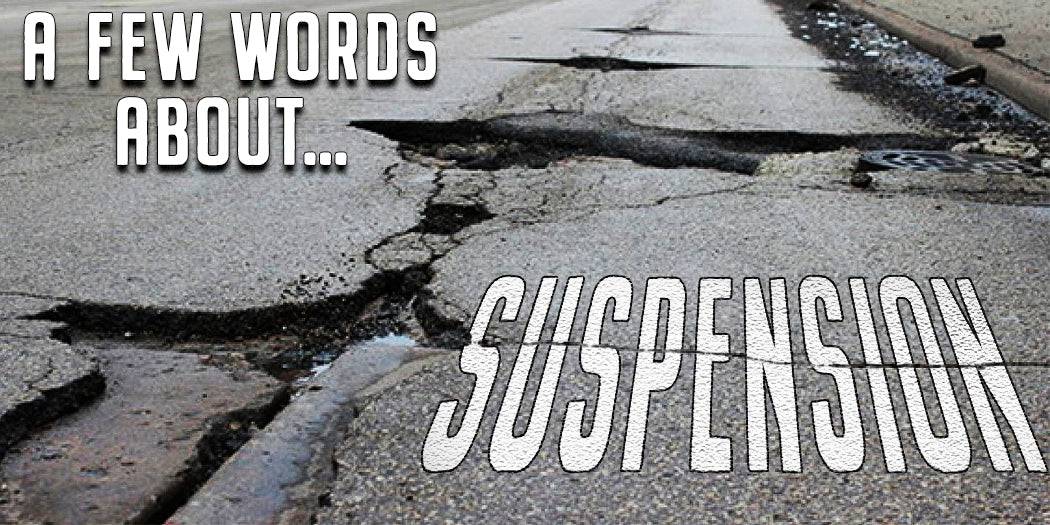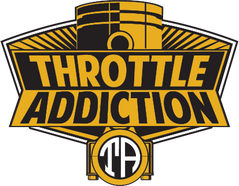
Comfort Versus Style - Motorcycle Suspension Products
I came up with this idea when I was working on the new Throttle Addiction Catalog. Holy shit there are a LOT of suspension products out there! No wonder, considering people want to get to their destination alive, in comfort, and in style. I'm glad I have to pack so many damned shocks, springers, pre-load adjusters, tubes, springs, triple trees, etc. into the catalog. But how do you decide when to prioritize the looks of your chopper or bobber, and when do you prioritize the comfort of the ride? Suspension can wreck the attitude of a bike, your ass, or both.
Motorcycle Front Suspension Explained
More common nowadays is the telescopic fork. A motorcycle telescopic fork takes road impact shock and transmits it up the fork, using its ability to move through its travel length to absorb impacts. Modern forks do this extremely well and are very smooth. However, the energy still flows up the fork and into the frame and ultimately will affect the bike if the impact is greater or faster than the fork's ability to absorb it.

Telescopic fork on a Harley-Davidson Sportster
Telescopic forks have two adjustable legs that move independently. When telescopic forks are under compression from an uneven surface, or you take a corner hard, one side will compress more than the other. This results in fork flex and a wheel that will not sit dead center between the fork legs. Fork braces lessen this effect and remove much of the wheel slop and brake dragging. The stiction will still be increased with side loading and will cause the fork to not feel as smooth as it should.
Pre-loading Motorcycle Front Suspension
"Bottoming out" occurs when the suspension is compressed to the point where it mechanically cannot compress any more. "Topping out" occurs when the suspension extends fully and cannot mechanically extend any more. Motorcycle suspensions are designed so that the springs are always under compression, even when fully extended. Pre-load is used to adjust the initial position of the suspension with the weight of the motorcycle and rider acting on it. Increasing pre-load increases the initial force on the spring thereby reducing total sag. Decreasing pre-load decreases the initial force in the spring thereby increasing total sag. Pre-load adjusters replace your stock fork caps and allow you to fine tune your front suspension. Throttle Addiction has a wide variety that can make dialing in your fork easy and worth it.

Speed Merchant - 49mm Fort Preload Adjusters View product
If you're going with a longer set of fork tubes for your chopper, upgrading to a stiffer, stronger triple tree provides more stability at high speed. Some come with a modified offset to increase the trail like our Speed Merchant series. The best thing about telescopic forks is the fine tuning you can do yourself. You can modify the length of the tubes to be longer, or you can go the other direction if you want to lower your bike. We also have these cool gold titanium nitride coated tubes that look badass.
How much do Springers Actually Soften Suspension?
Get yourself a font end that can do both. First off, you can't beat the awesome looks of a classic springer. Second, some well-designed springers like our Vintage Big Twin Style can take anything the road can throw at it. Beefier legs and welds are combined with exact engineering. Seriously, with decades of tweaking we have found a springer that can hold up to today's infrastructure cutbacks and frost heaves.
Springers Vesus Telescopic Forks
Understanding how a springer works is helpful when making the decision to mount one on your bike. The forces a springer takes on is a little different than telescopic forks- every bump a springer encounters will move the wheel up and back towards the rest of the bike. The leading fork legs transfer energy up into the springs with a jolt of force where as the trailing fork legs will flex back and up with the impact, resulting in opposing forces from the same impact. Longer springer forks will have more dampening from the metal itself absorbing and spreading impact forces due to the flexibility of the metal and will feel smoother because of this. One of the great things about springers is their simplicity and ease of maintenance. Our springers come with grease zerk fittings on the lower rockers and springs. Look at this cool diagram I made to help folks understand the punishment our springer takes (and laughs off):

View Throttle Addiction Springers
Motorcycle Rear Suspension Explained
If you aren't running a hardtail, chances are you have a set of sweet shocks on the back of your bike to save your ass some pain and discomfort. Better yet, if you have a passenger it makes every gas stop a bit more tolerable because you don't have to, "hear about it". Yeah, yeah- getting new rear shocks can be a pain unless you truly know exactly what they do for your money and how damned fancy they can be. Read this small blurb and then check out the many shocks we offer if what you have right now just doesn't cut it.

Shock Absorber on a Harley-Davidson Sportster
Most bikes use a coil-type spring wrapped around a hydraulic damping unit. This combined spring/damper design is compact, easy to site on a bike and relatively simple to manufacture. The spring is the simplest part of the unit, being basically just a length of thick metal wire-usually steel-wound into a coil shape. The dimensions and material of the spring will define its main characteristic: the spring rate. This is a measure of how much force is needed to compress the spring a certain amount. So a spring with a rate of 20lbs/mm would compress by one millimeter if you put a weight of 20lbs on it. Put 400lbs on it and it will compress 20mm. A "stiffer" spring (or higher spring rate) will deflect less for a given force, while a "softer" spring will deflect more.
Preloading a Spring and How it Affects Suspension Movement
Most units have a way to preload the spring, usually by means of a threaded or stepped collar. If you turn the collar so that it compresses the spring, it will affect how the suspension unit moves when you put a force on it including the weight of the bike. It's good to know that preloading a spring doesn't change its spring rate, so once the preload has been worked through, the spring operates pretty much as it did before.
As for damping, the damper body has a chamber filled with oil. Inside is a piston with small holes in it that seals against the inner walls of the chamber. As the shock compresses and extends, the piston is pushed through the oil and the oil passes through the small holes in the piston. The act of forcing the oil through tiny holes puts a drag on the shock's movement, absorbing the kinetic energy of the suspension movement and converting it into heat. There are many types and sizes of rear shocks so you can really personalize your ride. Check 'em out.
There you have it- a little bit about motorcycle suspension types. I left out a few options, but we have our hands full with the types explained above- for now...
